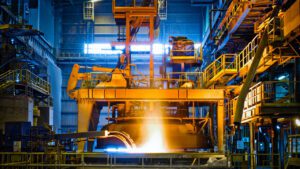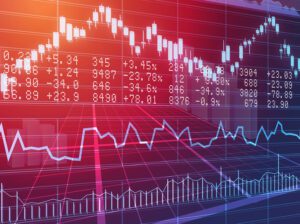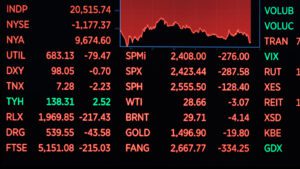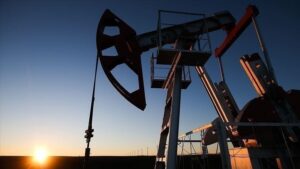
PrJSC “Ukrainian Graphite” (“Ukrgrafit”, Zaporizhia) following the results of work in 2021, increased its net loss by 2.2 times compared to the previous year – up to UAH 317.514 million from UAH 144.408 million.
According to the information on the agenda of the annual meeting of shareholders scheduled for November 30 of this year, which will be held remotely, the undistributed profit of the enterprise at the end of last year amounted to UAH 3 billion 527.125 million.
At the meeting, the shareholders intend to hear the report of the directorate on the work in 2021, approve it and decide on covering losses from the retained earnings received by the plant in 2018.
The shareholders will also terminate the powers of the members of the supervisory board and elect a new one.
In addition, the meeting will determine the main directions of the company’s activities in 2022-2024, including the modernization of the roasting and graphitization divisions.
“Ukrgrafit” is a leading Ukrainian manufacturer of graphite electrodes for electric steel-smelting, ore-thermal and other types of electric furnaces, commercial carbon masses for Soederberg electrodes, carbon-based lining materials for metallurgical, machine-building, chemical and other industrial complexes.
According to the National Depository of Ukraine (NDU) for the fourth quarter of 2021, Intergraphite Holdings Company Limited (Bermuda) owns 23.9841% of PJSC, C6 Safe Group Limited (Cyprus) owns 72.0394%.
The authorized capital of PrJSC is UAH 233.959 million, the nominal value of 1 share is UAH 3.35.

Investors evaluate the reporting of large companies and macroeconomic statistics.
The composite index of the largest companies in the region Stoxx Europe 600 by 11:07 a.m. CST fell by 0.77% and amounted to 407.03 points. Since the beginning of the week, the indicator has risen by about 2%, the highest rate since the end of July, writes Trading Economics.
The British stock index FTSE 100 fell by 0.82%, the German DAX – by 0.92%, the French CAC 40 – by 0.59%. The Italian FTSE MIB and the Spanish IBEX 35 lost 1.1% and 0.8% respectively.
The German economy in the third quarter grew by 0.3% compared with the previous three months and by 1.2% in annual terms. Analysts on average expected the first indicator to decrease by 0.2% and the second to increase by 0.8%.
French GDP in July-September increased by 0.2% qoq and 1.2% y/y, which coincided with market expectations.
Meanwhile, consumer prices in France, harmonized with European Union standards, jumped 7.1% year-on-year in October after rising 6.2% in September, according to preliminary data. Analysts polled by Trading Economics expected, on average, a much more moderate acceleration of inflation – up to 6.4%.
The Spanish economy grew 0.2% qoq and 3.8% yoy last quarter. Analysts polled by The Wall Street Journal expected growth of 0.3% and 4%, respectively.
Meanwhile, Spain’s October inflation stood at 7.3% year-on-year, falling to its lowest level since January from 9% in September, preliminary data showed. Growth was much weaker than the 8.4% rise expected by analysts.
Airbus SE shares are down 0.3%. The European Aerospace Corporation in the third quarter increased its net profit by 65%, earnings before taxes and interest payments (EBIT) – by 37%, revenue – by 27%.
Airbus confirmed its forecast that it expects to deliver about 700 aircraft to customers this year. Adjusted EBIT for 2022 is expected to be around EUR 5.5 billion.
Porsche AG is down 2.9%, although the German luxury car maker reported strong growth in operating profit and revenue in the first nine months of this year.
Capitalization of NatWest Group Plc falls by 8.5%, being the leader of the decline in the Stoxx Europe 600 index. The British bank (formerly the Royal Bank of Scotland) increased pre-tax profit in the third quarter to 1.09 billion pounds ($1.26 billion) from 976 million pounds for the same period a year earlier, but the figure was worse than the consensus forecast of 1.24 billion pounds.
The leading gainer among Stoxx 600 components was shares of Austrian oil and gas group OMV, which jumped 7.6%. The company recorded operating profit in July-September of 3.5 billion euros, which was 9% higher than the consensus forecast, and announced its intention to pay a special dividend of 2.25 euros per share.

Stock indices of the Asia-Pacific region (APR) are falling during trading on Friday, traders evaluate the results of the meeting of the Bank of Japan and quarterly reports of companies.
China’s Shanghai Composite fell 1.4% by 8:21 am KST, while Hong Kong’s Hang Seng fell 2.9%.
The drop leaders on the Hong Kong Stock Exchange are shares of Country Garden Holdings Co. Ltd. (-9.9%), China Mengniu Dairy Co. Ltd. (-9.5%) and Longfor Group Holdings Ltd. (-9.2%).
Shares of China CITIC Bank Corp. cheaper by 0.3%. The Chinese bank in the third quarter slightly increased net income on the back of an increase in net interest income and operating profit.
The value of the Japanese Nikkei 225 fell by 0.7% by 8:21 am KSK.
The Bank of Japan left unchanged the main parameters of monetary policy (MP) following the results of the two-day meeting that ended on Friday.
The short-term interest rate on deposits of commercial banks with the Central Bank was left at minus 0.1% per annum, the target yield on ten-year government bonds is near zero, the Japanese Central Bank said in a statement released after the meeting.
This was in line with the expectations of most analysts.
Meanwhile, unemployment in Japan rose to 2.6% in September from 2.5% a month earlier, according to data from the country’s Ministry of Internal Affairs and Communications.
On average, experts predicted that the indicator would remain at the August level, according to Trading Economics.
By comparison, unemployment was at 2.8% in September 2021.
The stocks of industrial robots maker Fanuc Corp are the most significantly depreciated. (-5.5%), which released quarterly results that disappointed investors and worsened annual demand, citing weakening demand in China.
Also among the drop leaders in the index are papers Kawasaki Kisen Kaisha Ltd. (-4.4%) and Hoya Corp. (-4.3%).
The South Korean index Kospi lost 0.6% by 8:25 am KSK.
Quotes of securities of one of the world’s largest manufacturers of chips and electronics Samsung Electronics Co. decrease by 3.2%.
Shares of another chip maker, SK Hynix Inc., fell 6.7% for a second straight session on the back of weaker-than-expected quarterly results and the company’s announcement of plans to cut capex.
At the same time, shares of automakers Kia Corp. grow by 0.8%, Hyundai Motor Co. – by 1.3%.
The Australian S&P/ASX 200 fell 0.9%.
The capitalization of the world’s largest mining companies BHP and Rio Tinto decreased by 5% and 4.4%, respectively.

Ukrainian agrarians have applied to the authorities of the Republic of Poland with a request to lay a broad-gauge railway line (with a gauge of 1520 mm) across its territory, which will connect the port of Polish Gdansk with the Ukrainian and Lithuanian railway networks to export agricultural products and ensure strategically important imports through western borders of Ukraine.
The corresponding appeal to the President of the Republic of Poland Andrzej Duda and its Prime Minister Mateusz Morawiecki was sent by the leading Ukrainian agrarian associations: the All-Ukrainian Agrarian Council (VAR), the Agrarian Union of Ukraine, the Ukrainian Agrarian Business Club, the All-Ukrainian Association of Communities, the Union of Poultry Breeders of Ukraine and the Ukrainian Agrarian Confederation, reportedly on the VAR website on Friday.
According to the appeal, one of the largest and closest European ports to Ukraine is the port of Klaipeda (Lithuania), which has significant free transshipment capacities. However, due to differences in the gauge between Poland, Ukraine and the Baltic countries, there is a need to reload the contents of wagons at border crossings between countries or rearrange wagon bogies, which does not allow to fully realize the export-import potential of the port of Klaipeda.
In turn, the use of vehicles or containers as an alternative to railway transportation is poorly suited for transporting bulk bulk cargo (coal, ore, grain, metal) over long distances and increases their cost to an uncompetitive level. In addition, in the case of using container terminals, the capacity of the railway line will be limited by their capacity, which will also prevent full use of the potential.
“In our opinion, the laying of a railway line with a gauge of 1520 mm across the territory of the Republic of Poland, which will connect the Ukrainian and Lithuanian railway networks, as well as connect the port of Gdansk to them for the transport of goods and passengers, will solve the above-mentioned problems,” the appeal of the Ukrainian farmers.
At the same time, it is emphasized that such a logistical path will give significant positive financial and economic effects for Poland and Ukraine, not only due to an increase in export-import capacities, but also due to the unification of the economic space of Poland, the Baltic countries and Ukraine.
Such a project can be implemented through the reconstruction of the existing railway network and the construction of a combined track, or the construction of a separate railway branch.
As reported, in June 2022, Polish Deputy Prime Minister Yaroslav Kaczynski said that the issue of building this broad-gauge railway track had already been tentatively approved by the Polish and Ukrainian governments.
In early June, the VAR already proposed to build 300 km of broad-gauge railway tracks in Poland for direct grain deliveries to the Lithuanian port of Klaipeda, which would allow not to overload the contents of wagons at the Ukraine-Poland and Poland-Lithuania border crossings due to the difference in railway gauge in these countries.

Oil prices are falling during trading on Friday after a steady rise the day before.
December futures for Brent on London’s ICE Futures exchange fell by $0.77 (0.79%) by 8:00 a.m. to $96.19 per barrel. As a result of trading on Thursday, they rose by $1.27 (1.33%) to $96.96 per barrel.
Quotes of WTI futures for December in electronic trading on the New York Mercantile Exchange (NYMEX) by the specified time decreased by $0.94 (1.06%) to $88.14 per barrel. According to the results of previous trading, they increased by $1.17 (1.33%) to $89.08 per barrel.
Despite Friday’s decline, oil prices may end the week with growth on the back of a sharp fall in the dollar, as well as data on US exports.
Meanwhile, investors remain cautious amid an uncertain demand outlook due to rising inflation, higher interest rates and growing recession risks, writes Trading Economics.
Earlier this week, it became known that US commercial oil inventories increased by 2.59 million barrels last week, while experts polled by Bloomberg expected a more moderate increase – by 1.5 million barrels.
The US Department of Energy report also reported that gasoline inventories fell by 1.48 million barrels, while distillate reserves increased by 170 thousand barrels. Analysts predicted a decline in gasoline by 1.5 million barrels, distillates – by 1 million barrels.

The US authorities in the new version of the national defense strategy described Russia as an “acute threat” and China as a “major challenge” for Washington.
“Russia poses an acute threat. Even though the main challenge comes from China, recent events highlight the immediate threat from Russia,” the Pentagon said in a strategy text released Thursday.
At the same time, the Pentagon noted that, “despite the fact that divergent interests and historical mistrust between China and Russia may limit the depth of their political and military cooperation, relations between the countries continue to expand.”
The document emphasizes that Russia “continues to pose a serious threat in key areas,” including nuclear.
This includes the nuclear threat against the United States and its allies and partners, the threat of long-range cruise missiles, cyber and information operations, threats in outer space, the threat of chemical and biological weapons, and underwater warfare. strategies.
In particular, according to the document, Russia continues to modernize and expand its nuclear forces, which pose a “potential threat to the existence of the United States and its allies and partners.” The Pentagon notes that we are talking about both the 1,500 deployed Russian nuclear warheads subject to the START III treaty, and warheads for non-strategic nuclear weapons, which are not covered by any agreements. Thus, Russia remains a rival to the United States with the most combat-ready and diverse arsenal of nuclear weapons.
At the same time, the document recalls, the United States had a significant dialogue with Russia in the area of ”strategic dialogue and crisis management.” The United States and Russia also expressed their desire to extend the nuclear arms control regime beyond the scope of START III. However, the priorities of both countries differ on this issue, which indicates the need for dialogue “with regard to those goals that the US and the Russian Federation do not have the same, and the perception of those weapons systems that affect strategic stability.”
US Secretary of Defense Lloyd Austin also presented this strategy at the briefing.